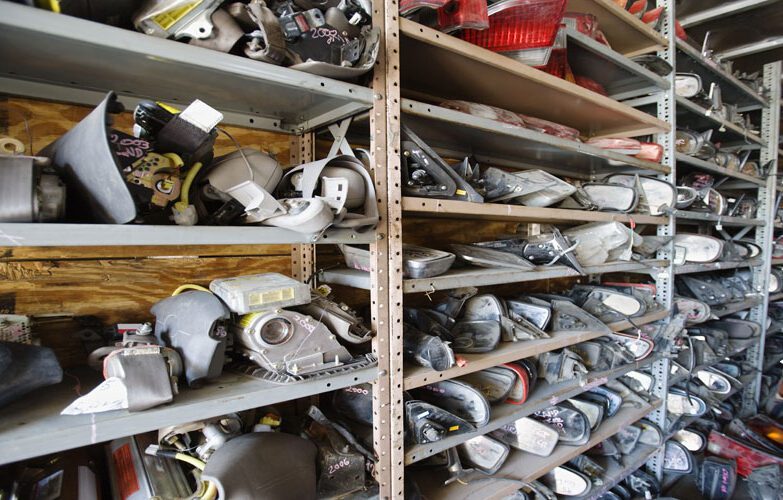Recycling Car Parts at Your Local Salvage Yard
Recycling car parts at your local salvage yard is a great way to promote sustainability and reduce waste. Salvage yards, […]

Recycling car parts at your local salvage yard is a great way to promote sustainability and reduce waste. Salvage yards, also known as junkyards or auto recyclers, specialize in collecting and dismantling vehicles to salvage and sell usable parts. Here’s a general guide on how to recycle car parts at a salvage yard:
Research local salvage yards: Look for salvage yards in your area that accept used car parts. You can search online directories or use search engines to find nearby options.
Contact the salvage yard: Reach out to the salvage yard and inquire about their acceptance policies and the types of parts they are interested in. Some salvage yards may have specific requirements or limitations on the parts they accept.
Assess the condition of the parts: Before taking your car parts to the salvage yard, evaluate their condition. Salvage yards typically accept parts that are still in usable or repairable condition. Parts that are damaged, broken, or in poor condition may not be accepted.
Remove the parts: If possible, remove the parts you wish to recycle from the vehicle. Salvage yards may pay more for parts that are already removed since it saves them time and effort. However, some salvage yards may offer assistance with part removal if needed.
Clean the parts (optional): While not always necessary, cleaning the parts before taking them to the salvage yard can help improve their appearance and increase their value. Use appropriate cleaning methods and ensure that the parts are free from any fluids or contaminants.
Transport the parts: Pack the parts securely to prevent any damage during transportation. If you have a large number of parts or heavy items, consider using a truck or trailer to transport them. Follow all local regulations regarding transportation of car parts.
Visit the salvage yard: Take your car parts to the salvage yard during their operating hours. Inform the staff about the parts you have and follow their instructions regarding drop-off or evaluation.
Negotiate a deal: Depending on the salvage yard’s policies, they may offer you payment for the parts, provide store credit, or offer an exchange for other parts. Discuss the options available and negotiate a fair deal based on the condition and value of the parts.
Properly dispose of non-recyclable parts: Some parts may not be suitable for recycling, such as severely damaged components or items containing hazardous materials. Ask the salvage yard staff for guidance on proper disposal methods for these parts.
By recycling car parts at a salvage yard, you contribute to the circular economy, conserve valuable resources, and support the automotive industry’s sustainable practices.Recycling car parts at your local salvage yard is a great way to promote sustainability and reduce waste. Salvage yards, also known as junkyards or auto recyclers, specialize in collecting and dismantling vehicles to salvage and sell usable parts. Here’s a general guide on how to recycle car parts at a salvage yard:
Research local salvage yards: Look for salvage yards in your area that accept used car parts. You can search online directories or use search engines to find nearby options.
Contact the salvage yard: Reach out to the salvage yard and inquire about their acceptance policies and the types of parts they are interested in. Some salvage yards may have specific requirements or limitations on the parts they accept.
Assess the condition of the parts: Before taking your car parts to the salvage yard, evaluate their condition. Salvage yards typically accept parts that are still in usable or repairable condition. Parts that are damaged, broken, or in poor condition may not be accepted.
Remove the parts: If possible, remove the parts you wish to recycle from the vehicle. Salvage yards may pay more for parts that are already removed since it saves them time and effort. However, some salvage yards may offer assistance with part removal if needed.
Clean the parts (optional): While not always necessary, cleaning the parts before taking them to the salvage yard can help improve their appearance and increase their value. Use appropriate cleaning methods and ensure that the parts are free from any fluids or contaminants.
Transport the parts: Pack the parts securely to prevent any damage during transportation. If you have a large number of parts or heavy items, consider using a truck or trailer to transport them. Follow all local regulations regarding transportation of car parts.
Visit the salvage yard: Take your car parts to the salvage yard during their operating hours. Inform the staff about the parts you have and follow their instructions regarding drop-off or evaluation.
Negotiate a deal: Depending on the salvage yard’s policies, they may offer you payment for the parts, provide store credit, or offer an exchange for other parts. Discuss the options available and negotiate a fair deal based on the condition and value of the parts.
Properly dispose of non-recyclable parts: Some parts may not be suitable for recycling, such as severely damaged components or items containing hazardous materials. Ask the salvage yard staff for guidance on proper disposal methods for these parts.
By recycling car parts at a salvage yard, you contribute to the circular economy, conserve valuable resources, and support the automotive industry’s sustainable practices.